Garmin GNX 120/130, 7- and 10-inch NMEA 2000 instrument displays
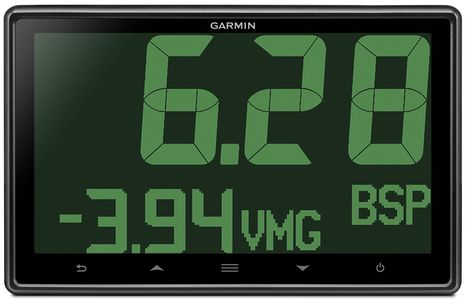 This morning Garmin announced the $900 7-inch GNX 120 and the $1,500 10-inch GNX 130 (above) with planned delivery in February and May respectively. They use what’s called “high-precision glass-bonded monochrome ultra-glow LCD displays” and the data backlighting can be switched to most any color. Set up is done with those onscreen touch buttons or with a new GNX Keypad . Over 50 NMEA 2000 data types will be recognized and there will be five display configurations including “single, dual and triple functions, plus Gauge and Graph mode”…
This morning Garmin announced the $900 7-inch GNX 120 and the $1,500 10-inch GNX 130 (above) with planned delivery in February and May respectively. They use what’s called “high-precision glass-bonded monochrome ultra-glow LCD displays” and the data backlighting can be switched to most any color. Set up is done with those onscreen touch buttons or with a new GNX Keypad . Over 50 NMEA 2000 data types will be recognized and there will be five display configurations including “single, dual and triple functions, plus Gauge and Graph mode”…
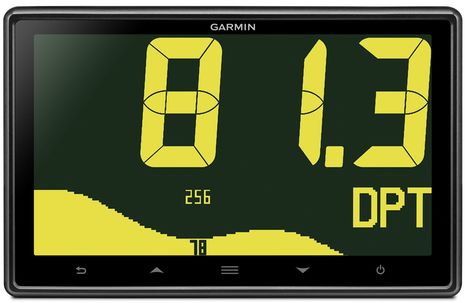 I can picture these displays becoming popular on high-end motor yachts — much as B&G instruments have earned space on many megayacht bridges — but obviously the focus is performance sailing. The top portion of the big “hybrid” LCDs seem to use efficient segmentation while pixels on the lower portion permit graphics and the whole power load is said to be less than 0.4 Watts night or day for either size. Note that the “256″ and “78” on the depth screen above are max/min for the graph time period, which is user configurable.
I can picture these displays becoming popular on high-end motor yachts — much as B&G instruments have earned space on many megayacht bridges — but obviously the focus is performance sailing. The top portion of the big “hybrid” LCDs seem to use efficient segmentation while pixels on the lower portion permit graphics and the whole power load is said to be less than 0.4 Watts night or day for either size. Note that the “256″ and “78” on the depth screen above are max/min for the graph time period, which is user configurable.
There is more detail on the GNX 120 and 130 product pages that literally just went live, though I don’t yet see anything about the carbon fiber mast bracket accessories seen below. This week Garmin also released a major software update that includes (for some MFDs) the Start Guidance feature I recently described. Now I’m wondering if the commenter or two who opined that Garmin wasn’t serious about sailboat racing would like a do-over 😉
PS: Here’s a better look at how the GNX Keypad will look. The four numbered buttons apparently control display presets, though I think you switch them one display at a time. Also, I think this remote is NMEA 2000 wired but not certain.


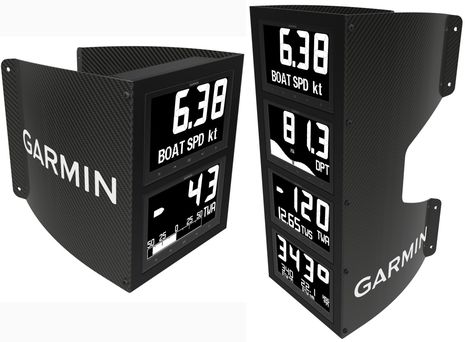
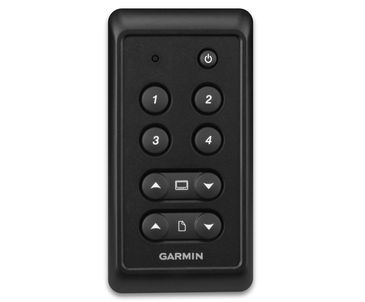



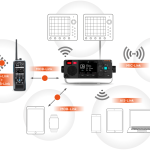







For a long time I’ve been waiting for proper maxi-displays that plug into NMEA2000.
This is just fantastic IF there is going to some way of getting custom numbers from navigation software into the displays.
Sail racers need things like target speeds and wind angles, laylines, information about next leg etc. that the race navigation software packages calculate. Most of the “legacy” instrument systems support these in way or another, but so far, the only way to get them into NMEA2000 network is to fudge some existing, but unused channel like engine RPM.
Excellent point, Jukka. To my knowledge there are no standard NMEA 2000 PGNs that cover the information you mention (though the online database — http://goo.gl/DCvPb6 — is out of date). But N2K does permit proprietary PGNs and the new Garmin Start Guidance is already generating values like Time-to-Burn and Distance-to-Line that would be great to have on the big mast displays for all the crew to see (particularly the trimmers).
So one question for the Garmin developers is whether they plan to push their own sailing-specific values to the GNX displays.
Allowing third party software to push values through the system is another matter, but it’s certainly possible, even via WiFi. So far Navico has shown more willingness to work with independent marine developers but I notice that Garmin is opening up more in other areas like smart watches: http://developer.garmin.com/
Overall, though, I guess these new Garmins are the first NMEA 2000 maxi displays (though I wouldn’t be surprised to see similar from B&G and maybe Raymarine).
B&G’s HV displays have been NMEA2000 for a few years…
Also from the looks of the specs on the website these displays cannot be powered off the N2K bus alone (unlike the trusty B&G 2020s etc). I can see the wiring for 4 of these at the mast being pretty complex.
Tom, I thought that too but when I looked this morning the online specs for B&G HV displays all say the interface is Fastnet. Isn’t that a proprietary B&G protocol?:
http://www.bandg.com/en-GB/Product-Groups/Other-Products-and-Accessories/HV-Displays/
Also I don’t see anything to indicate that these Garmin displays will need separate power feeds. In fact, if the 0.4W max spec is correct (HV is close) you could run 6 of the 10-inch GNX displays on the max 2.5W used by Garmin’s GMI 20, which is powered by the N2K bus.
What I bet Garmin did not do is put a second N2K port (female) on these displays because it’s against the NMEA rules (though it’s a really questionable rule, I think, and just about all the instrument competitors break it). Daisy chaining N2K instruments makes for a very tidy install, though failure of one can mean data loss for all others down stream. However, it’s usually not that hard to fit a multi-port or several tees screwed together somewhere nearby and all the displays can be on one spur from the backbone as long as the total cable length from backbone to any one display doesn’t exceed 6 meters.
There are 2 types of HV displays (I think they are the same hardware with different software)
The fastnet version are for pre-h5000 instruments including WTP3. The NMEA2000 version (which I think were marketed as Triton HV displays when triton was released) are NMEA2000 with micro-c connectors. H5000 uses the NMEA2000 version.
The common thing to do with the HV displays is to use one drop cable and 3 or 4 way block behind the mast bracket. I think this is still NMEA2000 compliant as long as the total cable length on that drop is less than 6m (correct me if I am wring)
Sorry I just noticed that I should have read all the way to the end of your comment!
Right you are, Tom. I didn’t dig down into Triton far enough:
http://www.bandg.com/en-GB/Product-Groups/Triton/Triton-HV-Displays/
So the B&G Triton HV 20/20 was probably the first NMEA 2000 maxi display.
Thanks, and no problem that we agree on how multiple displays can live on one N2K drop.
Great to see new hardware for the racing market. Displays are the one of the harder things to get right. The other is quality numbers (which comes from quality sensors and software). Will Garmin mint some advanced software in their instruments, or as suggested, allow others post their own data to the displays? It will be interesting to see specs or an API for posting data to these new displays.
Got some information at the boat show in Dusseldorf:
The displays are powered via N2k
There is a back cover included with the mast bracket which will house the wire harness used to connect the instruments. The only cable you have to run up the mast to the displays is a single N2k cable.
If the GNX120’s is used together with the GND10 (the interface between Nexus Network and N2k) you will also get a PC interface. That interface is running the FDX protocol which was developed by Nexus. There are today three SW’s on the market that can use that protocol and they are: Expedition, Adrena and SeaTrack. If any of these Sail Racing SW’s is used, there is 10 open channels called Custom Data where virtually any data may be send from the PC and displayed on the GNX120. For Expedition and Adrena not only the data is displayed but also the label (they didn’t know if SeaTrack worked that way).
I saw the display in Dusseldorf and they looked really nice. The Garmin guy I talked to claimed they would look even better in sunlight.
Thanks so much, John! And most of what you heard at the show was just confirmed by my US Garmin contact, who is reading these comments.
“3rd party software compatibility: 10 Channels to display information from tactical navigation SW like Expedition, Adrena and SeaTrack.”
That’s great news!
A little less than ideal though if it requires the computer to interface trough FDX. The FDX protocol is pretty old and I don’t think it supports stuff like AIS data – so another connection would be required for that.
Any word if the custom channels are available on the smaller GNX 20 / 21 displays too?
Good point Jukka!
The GNX 20/21 would serve as exellent mast displays on smaller vessels.
Agree with the akward setup with fdx. Seems quite old suddenly..
If you not have the need for a pc running expedition. Then it would be overkill.?
A GMI/GNX setup? Or would it have much less calibration possibillitys?
Convertion boxes seems to be a Quick fix to get something going.
Although. Im rally glad to see Garmin getting seriously about saling.
A Tiller pilot as the Ray EV-100. From Garmin would be great.
Hi Jukka,
If you want custom data form a Race SW (Expedition, Adrena etc.), you MUST have the PC running anyway. The PC is connected to the GND10’s (which comes with the gWind) USB port and will provide most data to the Navigation SW, not AIS though. I have used this system onboard my boat all summer and I just added a USB hub (which I bought for less than $10) so I only need one USB connection to my PC and by that I will get all data inc. AIS.
Hi,
The problem I have with Garmin’s requirement to use the old FDX protocol instead of native NMEA2000 PGNs is that there is plenty of data in the network that won’t be transferred across. AIS data was the first example I could think of, but looking at the specs of the GND10 box, I see that the heel & trim information sent by compasses won’t be available either.
So, I can either connect Expedition to the NMEA2000 bus with Actisense NGT-1 and have AIS and vessel attitude data OR connect trough GND10 and have the custom channels. I guess it is possible to have both connections hooked up at the same time, but that a lot of unnecessary complication for no real technical reason.
Nick White, the developer of Expedition software chimed in to the discussion about these displays on the Sailing Anarchy forum and stated that “Garmin isn’t particularly keen on making the proprietary PGNs available” ( http://forums.sailinganarchy.com/index.php?showtopic=163193#entry4814427 ). Why is that? To sell more GND10 boxes? Couldn’t they just have two modes in the GND10 – FDX for backwards compatibility with old Silva/Nexus gear and NMEA2000 for new installations?
Come on Garmin – just publish the PGNs for the custom channels and you’ll have a killer product!
The situation with the custom channels seems even more nonsensical now.
I acquired a GND10 box to give it a try in practice. Turns out that without the legacy Nexus FDX server connected via the Nexus bus, it does nothing.
So in order to have the custom channels I would need to have the GND10 and a FDX server connected even though I wouldn’t have any FDX instruments or sensors.
That seems a bit unfair, Jukka, as the $200 GND10 Bridge does a lot for the intended audience of Nexus sailors:
https://buy.garmin.com/en-US/US/on-the-water/sail/gnd-10-black-box-bridge/prod144123.html
So does the $400 Nexus Server:
http://www.p2marine.com/marine-electronics/nexus-instruments/nexus-server.shtml
But I agree that it would be nice if Garmin published the PGNs for custom info so that a program like Expedition could push them through a regular N2K gateway like the Actisense (though that may also require some work on Actisense’s part). It might be a smart competitive move for Garmin, too, and maybe I’ll get a chance to mention that in Miami next week 😉
Don’t get me wrong, Ben – I really like the products Garmin puts out.
I was just hoping to build a pure NMEA2000 instrumentation for my new raceboat, but it appears that Garmin has decided to allow the custom channels for legacy Nexus customers only. That’s what is not making sense to me. I would be happy even if a pure NMEA2000 connectivity required purchasing a Garmin-brand USB interface box instead of using the Actisense as long as all data is natively passed trough.
I’m making a bit noise about this in hopes that people at Garmin notice the issue and reconsider. Perhaps I come across more harsh than I mean to, because, well, I’m Finnish 😀
No worries, Jukka, and I do have a meeting with Garmin GNX experts on Thursday afternoon in Miami (if I can get there from here ;-). Anyone with questions please let me know.
Ben, ask if Garmin has given thought to any more sailboat racing features, such as displaying target boat speed as calculated by a PC or smartphone application that would have our polars.
Hi Ben
The GNX displays (also the small ones) look compelling, but Garmin’s strategy as regards sailing is unclear and the portfolio at this time too limited to buy into a closed system. (if we at all should go for closed systems, which N2K is unfortunately heading to with all those proprietary and closed extensions).
Now, my questions for Garmin:
1. Would they be willing to publish their proprietary N2K sentences used to feed (and possibly control) the displays? It would be cool not only to feed custom data, but also e.g. to control the display pages with the PC.
2. Would they be willing to publish the FDX specs? If they do not want to let others communicate with their devices directly through N2K, they could at least enable communication with the GND10. I called Sweden a while ago asking for the specification, but they refused, for “strategic” reasons.
Best, Peter.
@Peter
I wonder, under the terms of NMEA 2K, if Garmin is able to divulge any bit level detail re: the encoding of the 2K used to drive these displays.
That said, I whole heartedly agree with your macro point … I’m tired of closed interfaces on these systems.
@Ben, my question to Garmin would be … do they have any plans to provide GoFree like APIs to allow third parties to interface with this (or any other) Garmin kit?
Thanks
@Sparky
I think they can, as long as they do not disclose those standard PGNs that are part of the N2K spec. For example, Airmar uses and Maretron used (unfortunately they stopped for their newer products, as far as I can see) to do it. But I agree, what’s the point of having a, say, compass being able to feed displays of different manufacturers, if I need a display or even a MFD of the compass manufacturer simply to start the calibration procedure. This defeats the purpose of an open standard.
Best
Peter
Good news for racing sailors wanting to use GNX displays with third party software: Garmin realized that they can put all 10 custom data messages and text labels into one PGN that will be made available to established developers like Expedition. They think it can be passed from PC to NMEA 2000 network with an Actisense NGT-1 gateway, no GND10 or Nexus Server necessary. The plan is a bit tentative but I think I’ll get more detail soon.
Dan, values like target speed based on polars is already available on the Garmin system via the GND10 and Nexus.
Finally, I got to see the GNX displays, even in bright sunlight, and they look great.
Ben
Thanks a lot for following up on our questions. Unfortunately, “established developers” means closed 🙁
Best, Peter
Well, Peter, that seems like an opinion, and a fairly extreme one, about the nature of closed and open. With the Garmin custom message and label PGN open to established developers, many racers can potentially benefit. We have to remember that Garmin and other manufacturers run their autopilots and other critical systems using the same NMEA 2000 network. It seems reasonable that they want to be careful about who puts what on that network.
Garmin’s Jon Josephson, a racing electronics expert who worked for both Nexus and Garmin before they became one, wanted to add these notes after our Miami discussion:
“One thing I forgot to discuss was our support for the Nexus product line and what has been going on with the line.
1. We have created the GND10 as a interface bridge between the Nexus network and NMEA 2000
2. Garmin has created special part number kits which give the current Nexus owner the ability to purchase a GND10 and a GNX20 or GMI 20 for the same list price as a Nexus NX2 Multi $599.99.
3. We have continued support for the Nexus customer by creating adapter cables for the gWind so it can be used with the Nexus systems. We also have the GST 10 which allows the Nexus owner to use their current log transducer to adapt to NMEA 2000 without much fuss.
4.We are still supporting and selling all the parts which are part of the Nexus NXR line as we transition the NXR line into the Garmin product family. This means that if you need a Nexus product and its part of the NXR product line it’s still available.
5. The main engineers and sales people that were at Nexus are now fully integrated into the Garmin family. This will bring new and exciting products to the sailing market in the future without forgetting those customers past Nexus customers.
We believe the future of the sailing market will be better served with the power of Garmin, a new type of thinking about features but without forgetting the past. The time has come for a new competitor in the sailboat market.”
Further to this, we have just added support for the Garmin GNX120/130 custom channels to Expedition.
It works very well and finally gives us a good way to display sail boat relevant numbers on N2K networks.
I have all my data on the Raymarine bus, and I’m looking to add mast repeaters to our racing sailboat. This looks like a possible solution, and cheaper than many. Does anyone know if the transceiver is Raymarine compatible? If I can get N2K out of the Raymarine hub, and into the transceiver, I should be able to add the displays at the mast, get the data to them over wifi. Do I have that correct?
Tentatively yes, Kevin, but please tell us what Raymarine instruments and bus you have and what “transceiver” you reference?
Sorry, should have been more specific out of the gate. All Raym are e-series mfds, autopilot, etc. The transceiver would be the Garmin GNT10 (https://buy.garmin.com/en-US/US/shop-by-accessories/nmea-2000/gnt-10-nmea-2000-transceiver/prod124640.html)
Kevin, what model instrument displays are showing your wind/depth data now? Does your boat have a SeaTalkNG network (Ray’s form of NMEA 2000) or are the instruments & MFDs using regular SeaTalk?
PS The Garmin GNT10 is irrelevant to your project.
We have 3 raymarine e series displays right now – one 9″ mfd / plotter and 2 of the 5″ displays. I believe that it is all seatalk ng. The hub is a raymarine itc5, and I’m pretty sure that uses ng.
Easy then, Kevin! You just need to extend your SeaTalkNG network to the Garmin GNX using a patch cable that goes from STng white spur connector to standard female N2K Devicenet connector. Raymarine sells a 1 meter one as part # A06075.
You may also need to reconfigure your STng network a bit if you don’t have any available spur connectors or they aren’t close enough to the new Garmin display(s). Don’t do it, though, unless you understand how STng networks go together. Ray has a good guide and a pro installer will understand how to do it immediately.
Incidentally, the ITC5 is not a hub; it’s simply a data converter that can be anywhere on an STng or N2K network, which don’t have hubs.
http://raymarine.com/view/?id=3338
Ben,
Thanks for this info. I’m working with Kevin on our project and this is very helpful. Just a quick clarification:
I’m assuming that we use the iTC-5 to plug into the existing STng backbone (using one of the two backbone connectors and term the other one), and then use the white spur connection on the iTC-5 to connect to the STng end of the patch cable (A06075), and then connect the other N2K end to a run to the GNX120 cluster. Does that sound right?
Best,
Jon
Hi Kevin,
Another good source on how to design a NMEA2000/SeaTalkNG is this:
http://www.maretron.com/products/pdf/Network%20Installation%20Guide.pdf
Without a diagram I can’t really tell what you’re up to, but here are some thoughts:
*Yes you can add the iTC-5 to the end of the STng backbone (or anywhere else along the backbone). Just make sure that there is a terminator at each end of the backbone (aka trunk) and no where else.
*Yes, you can use the patch cable as a drop or spur from the iTC (or any other white STng connector along the backbone). But the “Garmin cluster” must meet the limitations of a drop: no device can be more than 5 meters of cable away from the backbone/trunk. It’s not supported by STng itself but it’s ok if there is a Tee or MultiPort as part of the drop/spur. But no terminators.
Hi Ben,
I have a very similar question about the setup N2K/STng : I’m planning on using 2 GNX , with a STng backbone.
the 2 options are:
Option #1 : link the 2 GNX vith n2k drop cables to 2 T-pieces connected together. add an N2k terminator on one end of the T assembly, and connect the other end of the T assembly to the STng backbone with one N2K/STng spur adaptor
Option #2 : individually link each GNX to the STng backbone with N2K/STng spur cables
Option #1 is easier but I’m not sure it’s right,
Option #2 is sure to work, but would require me to buy more cables.
what do think of option #1 ?
Thx
Jerome, why does Option #1 include a terminator?
Are you removing a terminator somewhere else?
Ben,
Can you advise whether the configuration of data sources will enable choosing boat speed, twa and tws generated by Expedition through a Actisense NGT-1?
Cheers.
Yes, Terry. Here’s a note from Garmin:
“I assume that the poster is asking if he could take in NMEA 2000 data into Expedition and send back out Expedition calibrated data. The answer is YES. What they would do is have the sensor data sending to Expedition and then do the calibration is Expedition then rebroadcast out to n2k as a Custom data field with a text tag like BSP EXP or something to note it as not sensor data. Then they would just display the BSP EXP instead of the regulator sensor BSP. In fact you could do a auto scroll between two if you want. This would also be the same for Wind and heading info. They could also just choose the NGT1 as the Boat speed source if they want to as long as EXP is outputting the corrected NMEA 2000 boat speed data. This would also be true for Wind and Heading data. This would keep the custom fields for other data from Expedition.
Make sense?
Here is a nice shot of the displays in action sailing to Hawaii during the recent Transpac.
https://www.youtube.com/watch?v=URuh84IrEfU
They are being fed Target and corrected wind data from Expedition.
Hope this helps. ”
Thank you Ben,
Exactly what I wanted to know.
Terry.
I wonder what the latency is from the measured source. The worst case with a hybrid system would be: sensor > instrument system > (B&G) hlink or nmea > Expedition > NGT > Garmin display. It would be interesting to compare this to pure n2k sensors > NGT > Expedition > NGT > Garmin displays. But some sensors (boatspeed) are too slow in n2k land, so aother scheme (such as hybrid) is needed for a performance oriented system, which brings me back to the latency question.
Here’s a reply from Garmin’s Jon Josephson to emsusa:
“The poster emsusa is correct if you try to make too many translations like a Sensor>Processor>NMEA 0183>Actisense>N2K>Display you can have latency issues. So it’s important to understand what the end result may be and what data you may be sending so the customer will have a good experience.. On many 8 kt cruising boats having a refresh rate of say 1 hz (if my math is right, that’s about 14 ft per second) may not be a big issue but on a 30 kt boat that 1 hz is an issue. It’s also a issue if you want to do many up line math calculations as the data just gets slower or “old”.
In some on the water testing we have seen where users are taking a B&G H3000 system (remember the sensor data is all into a central processor thus kind of having fast sensor data) then outputting on 0183 at 1 hz through a Actisense to n2k. Mostly we find they will not be using any kind of display dampening on the displays at this point, just the raw 1 hz data from Actisense. If they were to use all NMEA 2000 sensors with a fast update rate to the network that same data may need to have display dampening set in the displays to actually be able to read the data. So yes it would always be better to use a NMEA 2000 sensor array as it will give you maximum performance and flexibility however as you know many times there are trade offs when designing a system especially when trying to use other products that are already onboard.
Since the poster mentioned Boat Speed data speed here is the shameless Garmin plug. Garmin has updated both the GST-10 (analog speed to n2k adapter) and the GND10 (Nexus sensor or gWind n2k adapter) so that the analog output from those devices (I.E. Airmar speed transducer) is faster than 1 hz (standard of the current range of smartducers) The GST 10 will output BSP at 5 hz and the GND 10 will output BSP at 3 hz. So almost anyone can have faster than 1 hz boat speed data.
https://buy.garmin.com/en-US/US/shop-by-accessories/sensors/gst-10/prod35610.html
http://www8.garmin.com/support/ch.jsp?product=010-01226-00
Jon:
It’s great to hear you are still with Garmin. You helped me with my initial Nexus configuration many MANY years ago. I think we met at one of the Annapolis Sailboat Shows a long time ago.
I have just learned (from Dathan at Garmin) that there is no assurance that a new GND-10 unit will be loaded with the 2.2 software. There is still inventory on the shelf and being shipped that has older versions of the software. He indicated that there is currently no process to ensure the latest software revision prior to shipment. This is not a problem if you have a Garmin Chartplotter (with a memory card slot) as you can update the GND-10 software from that. BUT, if you don’t have a Garmin Chartplotter, your options for updating the GND-10 software are limited.
I am in the process of working out the arrangements to send my GND-10 (version 2.0 – purchased last fall) back to Dathan at Garmin so it can be updated (hopefully this will resolve an issue I am experiencing with the GND-10 and my Nexus NX2 FDX system). As he indicated to me, the process of updating the GND-10 for those without a Garmin Chartplotter was not completely thought through (his words, not mine).
I bring this up as you mentioned the update rate for boatspeed – that change was made (based on your documentation link) in version 2.1.
Eric
Eric, Garmin is still the only manufacturer I know of that offers a simple, inexpensive solution for updating their NMEA 2000 devices if you don’t have a Garmin MFD with SD card slot on the system:
https://buy.garmin.com/en-US/US/shop-by-accessories/nmea-2000/nmea-2000-network-updater/prod67781.html
Ben:
I meant to ask that question of Dathan at Garmin. I saw that device after our last correspondence. Do you know if it will work with the GND-10?
Eric
Ben:
Dathan at Garmin confirmed that the Garmin NMEA 2000 Updater can be used to update the software on the GND-10 (it is not listed in the list of supported devices on the Garmin site).
That provides another option!
Eric